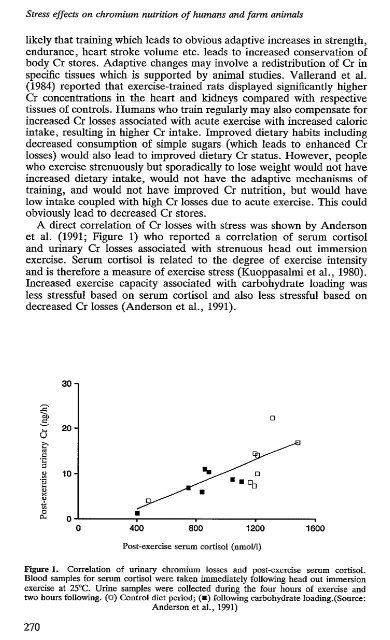Stress Effects on Chromium Nutrition of Humans and Farm Animals
Stress Effects on Chromium Nutrition of Humans and Farm Animals
Stress Effects on Chromium Nutrition of Humans and Farm Animals
Create successful ePaper yourself
Turn your PDF publications into a flip-book with our unique Google optimized e-Paper software.
<str<strong>on</strong>g>Stress</str<strong>on</strong>g> effects <strong>on</strong> chmmium nutriti<strong>on</strong> <strong>of</strong> humans <strong>and</strong> farm animals<br />
likely that training which leads to obvious adaptive increases in strength,<br />
endurance, heart stroke volume etc. leads to increased c<strong>on</strong>servati<strong>on</strong> <strong>of</strong><br />
body Cr stores. Adaptive changes may involve a redistributi<strong>on</strong> <strong>of</strong> Cr in<br />
specific tissues which is supported by animal studies. Valler<strong>and</strong> et al.<br />
(1984) reported that exercise-trained rats displayed significantly higher<br />
Cr c<strong>on</strong>centrati<strong>on</strong>s in the heart <strong>and</strong> kidneys compared with respective<br />
tissues <strong>of</strong> c<strong>on</strong>troIs. <strong>Humans</strong> who train regularly may also compensate for<br />
increased Cr losses associated with acute exercise with increased caloric<br />
intake, resulting in higher Cr intake. Improved dietary habits including<br />
decreased c<strong>on</strong>sumpti<strong>on</strong> <strong>of</strong> simple sugars (which leads to enhanced Cr<br />
Iosses) would aIso lead to improved dietary Cr status. However, peopIe<br />
who exercise strenuously but sporadically to Iose weight would not have<br />
increased dietary intake, would not have the adaptive mechanisms <strong>of</strong><br />
training, <strong>and</strong> would not have improved Cr nutriti<strong>on</strong>, but would have<br />
low intake coupled with high Cr losses due to acute exercise. This couId<br />
obviously lead to decreased Cr stores.<br />
A direct correIati<strong>on</strong> <strong>of</strong> Cr losses with stress was shown by Anders<strong>on</strong><br />
et al. (1991; Figure 1) who reported a correlati<strong>on</strong> <strong>of</strong> serum cortisol<br />
<strong>and</strong> urinary Cr Iosses associated with strenuous head out immersi<strong>on</strong><br />
exercise. Serum cortisol is reIated to the degree <strong>of</strong> exercise intensity<br />
<strong>and</strong> is therefore a measure <strong>of</strong> exercise stress (Kuoppasalmi et al., 1980).<br />
Increased exercise capacity associated with carbohydrate loading was<br />
less stressful based <strong>on</strong> serum cortisol <strong>and</strong> also less stressful based <strong>on</strong><br />
decreased Cr Iosses (Anders<strong>on</strong> et al., 1991).<br />
0 400 800 1200 1600<br />
Post-exercise serum cortisol (nmol/l)<br />
Figure 1. Correlati<strong>on</strong> <strong>of</strong> urinary chromium losses <strong>and</strong> post-exercise serum cortisol.<br />
Blood samples for serum cortisol were taken immediately following head out immersi<strong>on</strong><br />
exercise at 25°C. Urine samples were collected during the four hours <strong>of</strong> exercise <strong>and</strong><br />
two hours following. (0) C<strong>on</strong>trol diet period; (I) following carbohydrate Ioading.(Source:<br />
Anders<strong>on</strong> et al., 1991)<br />
270


